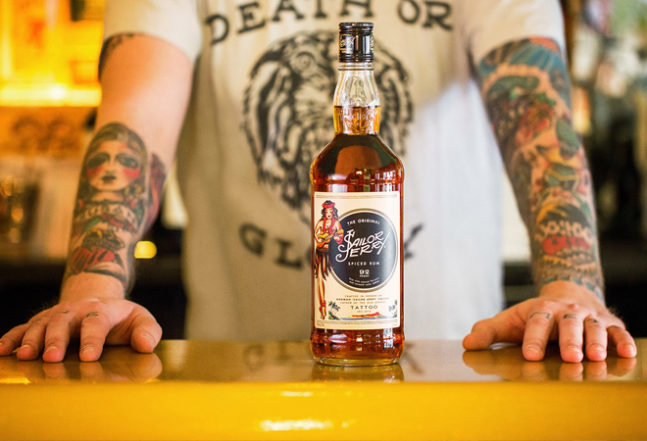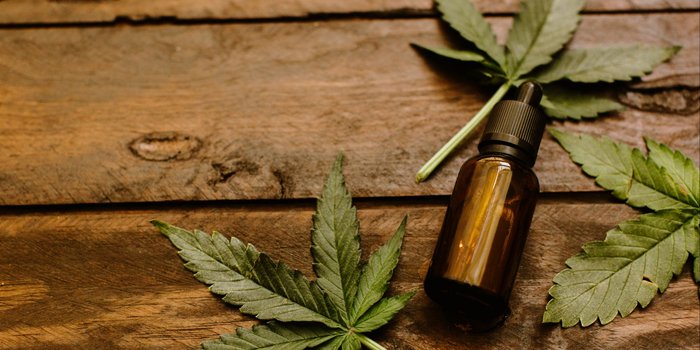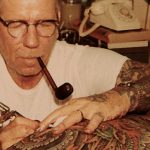By Bert Oliver
Norman “Sailor Jerry” Collins is a name synonymous with American tattooing. Hell, there are many out there who consider him the Godfather of American traditional style—and for all intents and purposes, they’re right. But Sailor Jerry’s story goes far deeper than most imagine. He wasn’t just some guy who decided tattooing was his calling. Aside from being a pioneer in one of the most traditional and widely revered styles of tattooing in the world today, he was so, so much more.
Two weeks ago, we met up with the team from Sailor Jerry Spiced Rum at Harley-Davidson’s 115th Anniversary Party in Milwaukee to learn about Norman “Sailor Jerry” Collins and what, exactly, made him the man the world remembers.
Norman “Sailor Jerry” Collins
Sailor Jerry was born Norman Collins on January 14, 1911, in Reno, Nevada. The “Jerry” moniker was actually given to him by his parents, according to Sailor Jerry Brand Ambassador Ashley Thomas, who gave us the rundown.
“He was given the nickname ‘Jerry’ after his father noticed a similar temperament between Norman and the family’s stubborn mule, and after a while, it just kind of stuck,” she said. “The ‘Sailor’ was added later when he joined the Navy.”

Running Rails and Hand-Poking Tattoos Across America
Sailor Jerry’s tattooing career started in his teens. After leaving his childhood home in Ukiah, California, Sailor Jerry started traveling around the country, hitchhiking down America’s highways and riding its scenic freight routes. It was here that he was first exposed to tattooing by a man only known as “Big Mike” from Palmer, Alaska.
As Sailor Jerry got older, his desire to perfect the art of tattooing grew with him. In fact, quick side note: Sailor Jerry literally made it a point to perfect anything he tried his hand at. But more on all that later. In the late 1920s, he met another famous tattooist named Gib “Tatts” Thomas, who showed him how to use a real-deal tattoo machine.
It’s worth noting here, too, that back in the old days, it was a real big deal for someone to agree to apprentice you. Not just anyone was taught the tricks of the trade, and “Tatts” himself was a world-renowned, well-traveled master of the art.
After a few years of practicing his craft on the drunks on Chicago’s Skid Row and wayward cadets from the Great Lakes Naval Academy, Sailor Jerry decided, at the ripe old age of 19, to himself enlist in the U.S. Navy.
Even a peek at Sailor Jerry’s old flash sheets shows his fascination with—and admiration of—nautical symbolism and sailor-themed tattoos, and his time in the Navy and Merchant Marines is obviously the reason for it.
Defining Long-Lasting Style
After holing up portside for the next few years all over Asia, Sailor Jerry finally “settled down” in Hawaii, where he opened up shop in Honolulu’s infamous Chinatown. It was here, really, where Sailor Jerry’s unique American tattoo style came into its own.
But tattooing isn’t all Sailor Jerry did.
Thomas told us that, when he wasn’t tattooing, Sailor Jerry was the captain of a three-masted schooner that he took people out on tours with. Aside from that, he was also a certified electrician, played saxophone in his own jazz band, and even, for a time, had his own radio show on Hawaii’s KRTG called Old Ironsides, where he’d share his political and philosophical views, as well as read his own poetry.
Oh, and he was an avid Harley-Davidson rider, naturally.
Perhaps one of the most interesting things about Sailor Jerry, however, was his fascination with Japanese culture and art. When the Japanese bombed Pearl Harbor in 1941, Sailor Jerry was so incensed that he tried to get back into the mud and reenlist. Even though he was denied, it didn’t stop him from joining the Merchant Marines.
Breaking The Mold
After WWII he returned to Hawaii where he, believe it or not, actually kept correspondence with several Japanese tattoo masters. In fact, Thomas explained to us that in several correspondences with these people (and other tattoo artists of the time period), Sailor Jerry would dedicate himself to learning every single detail of their tattoo styles—from the possibilities of tones and texture, to “crash” effects, different shading techniques, etc. He was obsessed with perfecting tattooing, and used his expertise in both American traditional and Japanese art to fuse the two culture together to create some of the boldest artwork the world has ever seen.
Not only does he have one of the most impressive bodies of tattoo work in the world, but Sailor Jerry was also a true pioneer for the craft. While it doesn’t sound like much, one of his greatest accomplishments was his invention of purple-colored ink. He’s also one of the first people to take equipment sterilization seriously.
Sailor Jerry died on June 12, 1973, three days after suffering a heart attack while riding his Harley. According to folklore, he woke up on the side of the road, wondering what happened, and not giving a single shit, apparently, got back on his bike and rode home. Before his death, Sailor Jerry made it known that he wanted his shop to go to one of three (or all of three) people: Ed Hardy, Mike Malone, and Zeke Owen. If none of the three wanted to step up and take over the shop, which was located at 1033 Smith Street (which, by the way, he re-opened after closing his first shop as a big “fuck you” to the IRS), then it was to be burnt to the ground.

About the Rum
Of course, you can’t really mention the name Sailor Jerry these days without bringing up the rum.
Mike Malone, one of Sailor Jerry’s most trusted friends and protégés, worked with the folks at Quaker City Mercantile to create a lifestyle brand in honor of Sailor Jerry’s legacy. William Grant & Sons purchased the brand in 2008 with the intention of keeping up the history and heritage of Sailor Jerry and his life.
Sailor Jerry may have had nothing to do with the invention of his namesake rum, but that doesn’t mean it doesn’t carry on his name well.
(86)





Leave A Reply